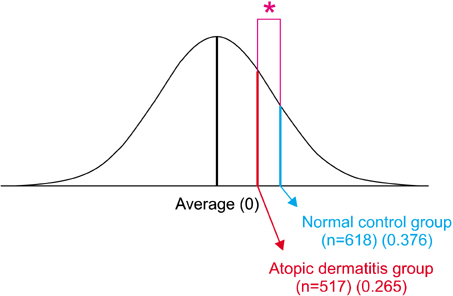Ann Dermatol.
2013 Feb;25(1):23-27. 10.5021/ad.2013.25.1.23.
The Short Stature in Atopic Dermatitis Patients: Are Atopic Children Really Small for Their Age?
- Affiliations
-
- 1Department of Dermatology, Chung-Ang University College of Medicine, Seoul, Korea. drseo@cau.ac.kr
- KMID: 2265967
- DOI: http://doi.org/10.5021/ad.2013.25.1.23
Abstract
- BACKGROUND
Short stature is sometimes seen in children with atopic dermatitis (AD); however, the topic has never been studied systematically. Objective: The aim of this study was to show whether AD itself affects stature in children and to evaluate the influence of other relevant factors such as genetic background, diet restrictions, and sleep disturbance on the stature of children with AD.
OBJECTIVE
The aim of this study was to show whether AD itself affects stature in children and to evaluate the influence of other relevant factors such as genetic background, diet restrictions, and sleep disturbance on the stature of children with AD.
METHODS
The study population included Korean children 7 to 8 years of age who live in one district of Seoul, Korea. We used a questionnaire as an investigating tool to survey genetic backgrounds, environmental factors, and comorbidities. Student's t-test and linear regression were employed for statistical analysis.
RESULTS
In univariate analysis, the average stature in the AD group was short compared with the normal control group. Parental stature, dietary habit, and sleep patterns were also relevant factors with respect to stature. However, in multivariate analysis, AD itself had no influence on stature. Significant correlations were found for such factors as parental height, sleep disturbance, presence of asthma, and dietary restrictions, in decreasing magnitude.
CONCLUSION
These results suggest that AD itself may not be the causative factor for short stature in children with AD. Therefore, consideration of other relevant factors related to short stature in patients with AD will be important for the proper management of the disease.
MeSH Terms
Figure
Cited by 1 articles
-
Economic Impact of Atopic Dermatitis in Korean Patients
Chulmin Kim, Kui Young Park, Seohee Ahn, Dong Ha Kim, Kapsok Li, Do Won Kim, Moon-Beom Kim, Sun-Jin Jo, Hyeon Woo Yim, Seong Jun Seo
Ann Dermatol. 2015;27(3):298-305. doi: 10.5021/ad.2015.27.3.298.
Reference
-
1. Kay J, Gawkrodger DJ, Mortimer MJ, Jaron AG. The prevalence of childhood atopic eczema in a general population. J Am Acad Dermatol. 1994. 30:35–39.
Article2. Rajka G. Natural history and clinical manifestations of atopic dermatitis. Clin Rev Allergy. 1986. 4:3–26.
Article3. Pike MG, Chang CL, Atherton DJ, Carpenter RG, Preece MA. Growth in atopic eczema: a controlled study by questionnaire. Arch Dis Child. 1989. 64:1566–1569.
Article4. Patel L, Clayton PE, Jenney ME, Ferguson JE, David TJ. Adult height in patients with childhood onset atopic dermatitis. Arch Dis Child. 1997. 76:505–508.
Article5. Ferguson AC, Murray AB, Tze WJ. Short stature and delayed skeletal maturation in children with allergic disease. J Allergy Clin Immunol. 1982. 69:461–466.
Article6. Cohen MB, Abram LE. Growth patterns of allergic children; a statistical study using the grid technique. J Allergy. 1948. 19:165–171.7. Ukabam SO, Mann RJ, Cooper BT. Small intestinal permeability to sugars in patients with atopic eczema. Br J Dermatol. 1984. 110:649–652.
Article8. Sloper KS, Brook CG, Kingston D, Pearson JR, Shiner M. Eczema and atopy in early childhood: low IgA plasma cell counts in the jejunal mucosa. Arch Dis Child. 1981. 56:939–942.
Article9. Tarnow-Mordi WO, Moss C, Ross K. Failure to thrive owing to inappropriate diet free of gluten and cows' milk. Br Med J (Clin Res Ed). 1984. 289:1113–1114.
Article10. Tanner JM, Goldstein H, Whitehouse RH. Standards for children's height at ages 2-9 years allowing for heights of parents. Arch Dis Child. 1970. 45:755–762.
Article11. Park YL, Kim HD, Kim KH, Kim MN, Kim JW, Ro YS, et al. Report from ADRG: a study on the diagnostic criteria of Korean atopic dermatitis. Korean J Dermatol. 2006. 44:659–663.12. Leung DYM, Rhodes AR, Geka RS. Fitzpatrick TB, Eisen AZ, Wolff K, Freedberg IM, Austen KF, editors. Atopic dermatitis. Dermatology in general medicine. 1993. 4th ed. New York: McGraw-Hill Book;1543–1564.13. Ashtoon R, Leppard B. Differential diagnosis in dermatology. 1992. 2nd ed. Oxford: Radcliffe medical press;103–105.14. Kristmundsdottir F, David TJ. Growth impairment in children with atopic eczema. J R Soc Med. 1987. 80:9–12.
Article15. Thomas MW, Panter AT, Morrell DS. Corticosteroids' effect on the height of atopic dermatitis patients: a controlled questionnaire study. Pediatr Dermatol. 2009. 26:524–528.
Article16. Murray AB, Fraser BM, Hardwick DF, Pirie GE. Chronic asthma and growth failure in children. Lancet. 1976. 2:197–198.
Article17. Patel L, Clayton PE, Addison GM, Price DA, David TJ. Adrenal function following topical steroid treatment in children with atopic dermatitis. Br J Dermatol. 1995. 132:950–955.
Article18. Vermeer BJ, Heremans GF. A case of growth retardation and cushing\'s syndrome due to excessive application of betamethasone-17-valerate ointment. Dermatologica. 1974. 149:299–304.
Article19. Allen DB. Effects of inhaled steroids on growth, bone metabolism, and adrenal function. Adv Pediatr. 2006. 53:101–110.
Article20. Campbell TA, Papadopoulosverge DJ, Verge CF, Williamson BD, Teng A. Incidence of sleep disorders in children with presumed normal variant short stature. J Paediatr Child Health. 2005. 41:358–360.
Article21. Charman C, Williams H. The use of corticosteroids and corticosteroid phobia in atopic dermatitis. Clin Dermatol. 2003. 21:193–200.
Article
- Full Text Links
- Actions
-
Cited
- CITED
-
- Close
- Share
- Similar articles
-
- Measurement of Atopic Dermatitis Disability
- Serum IgE Level in Patients of Atopic Dermatitis and Atopic Dermatitis with Molluscum Contagiosum
- Nipple Involvement in Atopic Dermatitis: Report of 3 cases
- Update on management of pediatric atopic dermatitis
- Therapeutic approach to atopic dermatitis in children


